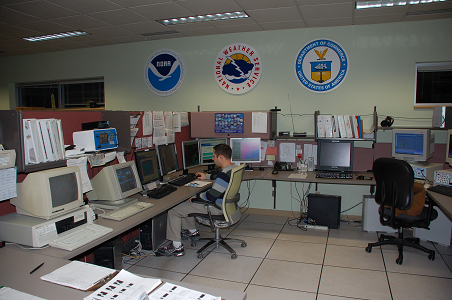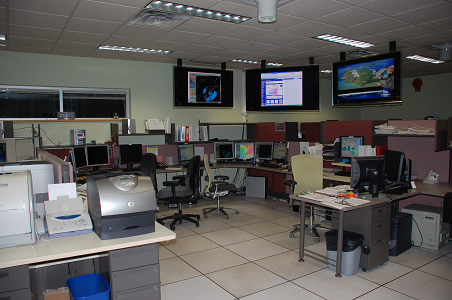 |
 |
Welcome to the Forecast Operations Area. Obviously, computers play a large role in the job of weather analysis and forecasting. Most of the computers you see in the top two pictures are a part of AWIPS, the Advanced Weather Interactive Processing System, which is our primary computer system. We'll discuss AWIPS in a bit more detail later in the tour.
The third picture from the top is our Situational Awareness Display. This keeps the staff alert of any high impact...or high profile situations across the region or nation that would require weather support from us.
There are always between 2 to 4 people working in the operations area every minute of the day. On a regular basis...these forecasters will produce a gridded forecast database using (IFPS/GFE) Interactive Forecast Preparation Software/Graphical Forecast Editor. We'll discuss IFPS/GFE in a bit more detail later in the tour. When you click on a point on the Point and Click map on our homepage...a detailed 7 day forecast is generated from the gridded forecast database our forecasters are constantly updating. In addition...a variety of familiar text products are created...including the general Zone Forecast, Coastal Marine Forecast, Hazardous Weather Outlook, Fire Weather Forecast...and various forecast matrices. The forecasters also create a a technical Area Forecast Discussion to discuss the reasoning behind what they are forecasting.
One forecaster will usually be in charge of the aviation forecast, writing coded products intended for use by airports, pilots and others associated with the aviation industry.
An intern will also be on duty. This staff member launches weather balloons; monitors NOAA Weather Radio broadcasts, and quality controls the weather observation from New York City's Central Park; and generates our daily climate products for our climate and co-op observer sites. This person is also responsible for writing the event-driven Short Term Forecasts.
During times of potentially hazardous weather, such as severe thunderstorms, flash flooding, or winter storms, additional personnel will be scheduled or work overtime to make sure warnings are issued in a timely manner. During these times, one or two forecasters will monitor the radar and issue warnings and statements, two others will continue to issue routine products, and anyone else on hand will help to answer the barrage of telephone calls from the media, emergency management officials, and the general public.
In order to make an accurate forecast, forecasters need to have measurements of current weather data. Continue on with the tour to see some of the equipment we use to collect these data.
|
|
|
|
|
|
|
|
|
|
|
|
|
|